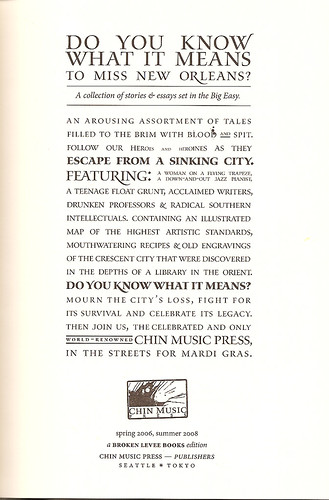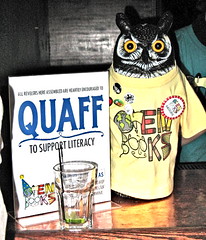 Is that not a great title page? The whole book is like that, marvelously designed. The cover image is Cassiopeia A: The colourful aftermath of a violent, stellar death. (This is the second edition, and I was torn, I tell you, torn! Do I buy the 1st because it's a first, or the second for the cover? You decide.)
Is that not a great title page? The whole book is like that, marvelously designed. The cover image is Cassiopeia A: The colourful aftermath of a violent, stellar death. (This is the second edition, and I was torn, I tell you, torn! Do I buy the 1st because it's a first, or the second for the cover? You decide.)You do have to read every word of this book. And I do mean every word. A tease from the copyright page: "All rights reserved. . . . Exceptions are made for book reviewers. By the way, there are no jokes here so you can stop reading if you are looking for them."
"This book was written and designed during three months in the fall of 2005." In the aftermath of Hurricane Katrina, Chin Music Press put together this slender, beautifully made anthology that will make you laugh and cry and rage. And cook. There are recipes, too. Interspersed throughout are engravings from the 1885 volume, Historical Sketch Book and Guide to New Orleans.
There are two ways to read this book. The first gathers the contributions into three sections: "The Dirge", "The Return" and "Lagniappe". But if it is too hard for you to read all those stories of ruin and devastation, one right after another, before reaching hope, there is an "Alternative Reading Order. Inspired by the many different versions of the song "Do You Know What It Means to Miss New Orleans?" I read it the second way and still shed more than one tear along the way. All over again, I saw the images of things that should never happen in this country, heard the stories of grace and generosity, stupidity and blindness.
Thank you to Toni McGee Causey for her eloquent essay, "Where Grace Lives". Thank you to Jason Berry, for his tale of evacuation, "The Holy City of New Orleans". Thank you to Colleen Mondor, who has never been to New Orleans for "Listen to the Second Line", about the music that I, too, love and cherish. Thank you to Ray Shea for the laughter and memories he shares in "I was a Teenage Float Grunt". Thank you to Rex (oh, appropriate first name!) Noone for his story of the power of celebration, "Professor Stevens Goes to Mardi Gras". Thank you to everyone who contributed to this book. But most of all, thank you to Chin Music Press, who gave it to us.
There are more voices here.













